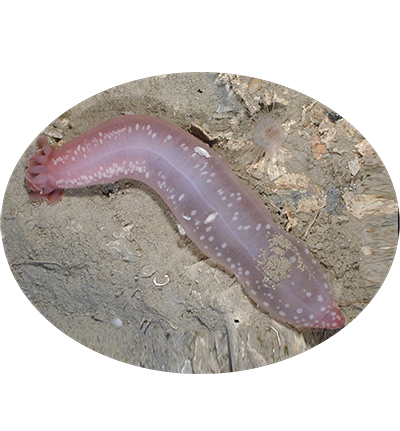
Chiridota heheva is a species of sea cucumber in the family Chiridotidae. The species is known from deeper regions in the Western Atlantic Ocean, but has a cosmopolitan distribution. It was described by Pawson and Vance in 2004. It occupies all three types of chemosynthetic ecosystems: hydrothermal vents, cold seeps, and organic fall. Unlike many other animals in similar environments, they do not host chemosynthetic bacteria.
Animalia (Kingdom); Echinodermata (Phylum); Echinozoa (Subphylum); Holothuroidea (Class); Paractinopoda (Subclass); Apodida (Order); Chiridotidae (Family); Chiridota (Genus); Chiridota heheva (Species)
Chiridota heheva Pawson & Vance, 2004
1. PAWSON D L, VANCE D J. Chiridota heheva, new species, from Western Atlantic deep-sea cold seeps and anthropogenic habitats (Echinodermata: Holothuroidea: Apodida)[J]. Zootaxa, 2004, 534(1): 1–13-1–13. (Pawson et al., 2004)
| Species | Phylum | Common Name | Ecosystem | Depth | Habitat | NCBI Taxonomy ID |
|---|---|---|---|---|---|---|
| Chiridota heheva | Echinodermata | deep-sea holothurian | Deep sea | 1,385-3,998 | Haima cold seep in the South China Sea (16° 73.228′ N, 110° 46.143′ E) | 2743191 |
| Genome Assembly | Genome Size | Assembly level | Released year | WGS accession | Submitter | BioProject | BUSCO completeness (%) | Scaffold/Contig N50 (kb) | GC content (%) | Repeat Rate (%) | Gene Number |
|---|---|---|---|---|---|---|---|---|---|---|---|
| ASM2015259v1 | 1.1Gb | Scaffold | 2021 | JAIGNY01 | SYSU | PRJNA752986 | 89.62 | 53,240/1,220 | 37.12 | 70.8 | 36,527 |
| Title | Journal | Pubmed ID |
|---|---|---|
| The genome of an apodid holothuroid (Chiridota heheva) provides insights into its adaptation to a deep-sea reducing environment | Communications Biology | 35273345 |
| Gene ID | Description |
|---|---|
| Chiridota_g10141 | - |
| Chiridota_g10142 | - |
| Chiridota_g10143 | ZINC FINGER PROTEIN |
| Chiridota_g10144 | - |
| Chiridota_g10145 | CYCLIN Y, ISOFORM A |
| Chiridota_g10146 | FATTY ACID DESATURASE 2 |
| Chiridota_g10147 | COILED-COIL DOMAIN-CONTAINING PROTEIN 14 |
| Chiridota_g10148 | - |
| Chiridota_g10149 | - |
| Chiridota_g1015 | - |
| Chiridota_g10150 | - |
| Chiridota_g10151 | KRUEPPEL-LIKE TRANSCRIPTION FACTOR |
| Chiridota_g10152 | - |
| Chiridota_g10153 | - |
| Chiridota_g10154 | - |
| Chiridota_g10155 | - |
| Chiridota_g10156 | - |
| Chiridota_g10157 | SET DOMAIN-CONTAINING PROTEIN-RELATED |
| Chiridota_g10158 | ANKYRIN REPEAT-CONTAINING PROTEIN DDB_G0279043 |
| Chiridota_g10159 | - |

